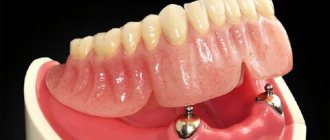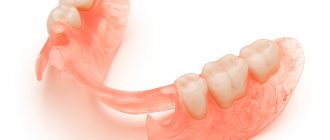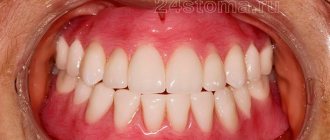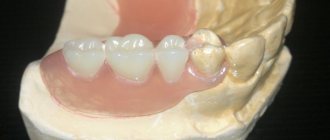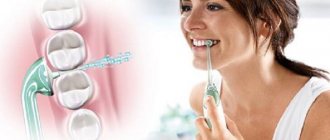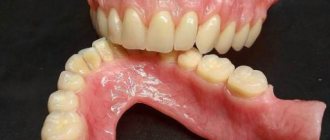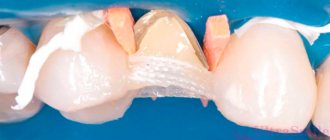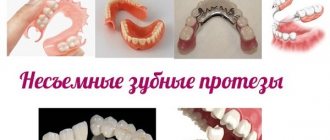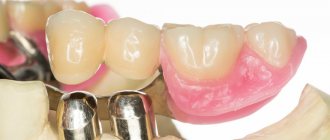The loss of one or two teeth is a reason to immediately make an appointment with a doctor who will help restore the unity of the row. Orthopedic and surgical dentistry offer many ways to solve this problem. The best of them is implantation, but it is not always possible to use it. Fixed bridge structures, which require grinding down the teeth adjacent to the defect, are not acceptable to everyone. But in such a situation, there is another remedy - the new generation “Butterfly” dentures. These structures can be produced as quickly as possible and installed immediately after the removal of any unit, while maintaining the integrity of the adjacent teeth.
Butterfly denture – why is it called that?
The butterfly denture got its name due to the similarity of its soft base to the wings of a butterfly. Of course, such similarity can be called conditional, since the shape of the prosthesis depends on the number of artificial teeth and the length of the supporting part. With a large loss of teeth in one jaw, the design turns into a clasp prosthesis on attachments and no longer resembles a butterfly: this is why it is customary to call only mini-prostheses for replacing one or two teeth.
The butterfly prosthesis is fixed in the mouth using clasps - special hooks that extend from the base of the structure: they are usually made of soft transparent plastic and tightly grip the supporting teeth.
Care
The structure does not require any special care; the following will suffice:
- after eating, rinse the butterfly with water, which will help remove food residues;
- Use toothpaste 2 times/day;
- To store the system, it is better to use a special solution, which is also used for conventional removable dentures.
Compliance with these simple rules will allow you to maintain the aesthetic appearance of the structure for a long time.
The cost of the structure will depend on the material used and the number of teeth that require restoration. For example, one unit of a system made using plastic costs 3–5 thousand rubles. If nylon is used to make a prosthesis, then the price will jump. In different clinics it can vary from 10 to 22 thousand rubles.
Sources used:
- Carr, Alan (2016). McCracken's Removable Partial Prosthodontics
- Agafonov A. Dental prosthetics: features
- Complications during dental prosthetics and their prevention / M.G. Bhushan, H.A. Kalamkarov. — M.: Shtintsa
When is a removable butterfly denture suitable?
As already mentioned, a removable butterfly denture is installed when it is necessary to replace one or two teeth. Most often this occurs after the implantation procedure, when it is necessary to replace the empty space while the implant is healing. First of all, this concerns the frontal zone, where aesthetics are important (do not walk around with a gaping hole instead of a front incisor). A butterfly denture for the front tooth is considered one of the most common removable structures when performing implantation in the aesthetic zone, but one should not think that when restoring molars and premolars, a temporary butterfly denture is not needed at all. The fact is that the loss of even one tooth seriously affects the functioning of the entire dentofacial apparatus. Firstly, the chewing load is not distributed correctly, which can lead to problems with bite and gastrointestinal tract (due to poor chewing of food). Secondly, neighboring teeth begin to shift to fill the missing space, so in the absence of a replacement prosthesis, the entire dentition slowly shifts, which can subsequently seriously complicate treatment. A butterfly partial denture solves these problems.
The only thing that such a prosthesis will not save from is bone tissue atrophy, which begins to occur after tooth extraction, but this problem is solved after the implantation of a titanium implant.
Indications and contraindications for the installation of butterfly prostheses
Orthopedic dentists recommend using butterfly dentures in the following cases:
- To restore the aesthetics of the dentition and chewing function during preparation for implantation and prosthetics. This will avoid displacement of teeth into the area of the defect, as well as rapid atrophy of bone tissue;
- If a tooth included in the smile area is removed. A butterfly prosthesis will help hide the defect and relieve a person from psychological discomfort;
- As a permanent prosthesis, if the patient has contraindications to permanent prosthetics or implantation, or the person does not want to resort to these methods of dental restoration for personal reasons.
But there are no contraindications to the use of butterfly prostheses. However, it is not always possible to apply them in practice - for example, there are no healthy supporting teeth to fix the prosthesis, the patient has abnormalities in the jaw structure that do not allow the butterfly to be firmly fixed in the oral cavity.
Pros and cons of butterfly dentures
The quality of a butterfly prosthesis directly depends on its material and the professionalism of the specialists who will install this structure. In general, a temporary butterfly prosthesis has two key advantages, due to which this design has been widely used in dentistry for a long time.
- Replacement of the chewing function of the tooth. It is better not to subject a removable denture to heavy loads, but it copes quite well with chewing regular food.
- Not bad aesthetics. Modern designs (especially the nylon butterfly prosthesis) provide a very decent aesthetic result. When using transparent clasps, the butterfly prosthesis will not be visible on the gums.
However, it should be understood that a complete tooth replacement cannot be carried out using this type of prosthesis. The butterfly prosthesis also has a number of disadvantages that many patients have to put up with while wearing it. All the pros and cons of this type of prosthetics are outlined in the table below.
- No grinding of teeth.
To install a butterfly denture, you do not need to grind down adjacent teeth. - Easy care.
The structure must be washed with running water and cleaned with a brush, and placed in a special solution overnight. - Low cost.
We will tell you more about how much a butterfly prosthesis costs below.
- Difficulties with adaptation.
Immediately after installation of a butterfly prosthesis, problems with diction and discomfort when biting may occur. - Fragility.
This prosthesis breaks quite easily and does not have a long service life. - Allergic reaction.
When installing dentures made of acrylic and plastic, allergic reactions are possible.
Varieties
Micro dentures for one or more units are usually made of acrylic plastic (acry free), nylon or regular plastic. Each type of device has its own disadvantages and advantages, which will be discussed below.
Butterfly made of ordinary plastic
The plastic prosthesis has pink shades and well imitates the natural tissues of the oral cavity. Using the design, you can install 1-2 missing elements. The base is held in place by 4 plastic clasps, shaped like shoots. With these clasps the base is attached to adjacent units.
The main advantage of an acrylic prosthesis is its low cost, good imitation of missing teeth and long service life (up to 8 years). The difference between cheap and expensive 1 tooth barrels is almost imperceptible. The material used for the prosthesis is important only when multiple defects in the mouth are being corrected.
Dentists do not recommend a plastic construction only if the front tooth will be restored. The fact is that plastic does not imitate your own gums as well as other types of expensive dentures. Another disadvantage of a plastic butterfly is the possibility of developing allergic reactions to the material. Acrylic plastic contains methyl methacrylate, which often causes irritation of the mucous membranes of the mouth.
Nylon butterfly
Nylon structures are considered quite elastic, which is why they are also called soft prostheses. The device is not suitable for restoring multiple dental defects, since in this case the elasticity of the product makes it impossible to fully digest food. In addition, a soft butterfly instead of a tooth can cause bone tissue atrophy.
When correcting 1-2 elements, deficiencies in the flexibility of the prosthesis are almost invisible. The clasps of the structure that hold the base in place are made of translucent pink nylon. This fact makes dentures almost invisible in the oral cavity.
Artificial teeth made of nylon have only one advantage - stunning aesthetics. Among the disadvantages of the product, it should be noted: high cost compared to plastic products, the impossibility of installation in case of inflammatory diseases of the oral cavity, and uncomfortable chewing.
Removable butterfly prosthesis – price in Moscow
The price of a butterfly denture, like all structures of this type, is not fixed. The cheapest samples cost an average of 3,000 – 5,000 rubles, but they are not always of high quality, which significantly affects the patient’s comfort. Budget prostheses are usually made of fairly hard plastic, which does not look very aesthetically pleasing and can also cause discomfort and even pain when worn. The price of a removable butterfly prosthesis made of nylon in Moscow dentistry will be more expensive (from 12,000 to 20,000 rubles for the most modern designs), however, from both a functional and aesthetic point of view, such systems are much more effective.
How are butterfly dentures made and installed?
Butterfly dentures are made quite quickly and simply, and this is one of the reasons why they have a very affordable price. We will describe the process of production and installation of butterfly prostheses step by step:
- Impressions are taken - from the tooth that will be removed, as well as from the supporting teeth, since in order for the butterfly to hold firmly in the mouth, the design of the prosthesis must take into account all the structural features of the supporting units;
- The finished cast is sent to the laboratory, where a butterfly prosthesis is made from it - made of acrylic or nylon. Clasps are placed on the prosthesis;
- After the butterfly is ready, the patient is invited to try on the prosthesis. If, after putting on and securing the prosthesis, a person feels discomfort, the butterfly is returned to the laboratory for correction to the required parameters.
If the fitting does not reveal any inaccuracies in the manufacture of the prosthesis, the doctor will install and secure the butterfly in the right place, and also explain to the patient how to care for the prosthesis.
USEFUL TO KNOW: If diagnostics reveals the presence of caries on the supporting teeth, a large amount of plaque, and tartar, then even before taking impressions, it will be necessary to carry out treatment of carious lesions, as well as sanitation of the oral cavity.
Advantages of removable immediate dentures
Immediate dentures are the most popular tooth replacement option. They are light, compact, easy to use and maintain, comfortable and do not cause inconvenience when wearing.
Their popularity is explained by several important advantages:
- fast production and installation;
- absolutely non-traumatic prosthetic procedure – no pain or discomfort;
- there is no surgical intervention during installation - this reduces the risk of infection and inflammatory processes;
- do not require grinding of supporting teeth;
- no contraindications;
- the absence of metals in the design guarantees the absence of oxidative processes and foreign taste in the mouth;
- do not rub or scratch gums;
- strong fixation (however, there is no 100% guarantee that it will not fall out);
- natural appearance – suitable for installation in the smile area;
- simple and easy care.
Butterflies can be placed on patients of any age, even the elderly and children. They do not cause allergies or other unwanted reactions.
MANUFACTURING PROCEDURE
In order to provide the patient with maximum comfort and convenience when wearing the prosthesis, the design is made as follows:
At the initial stage, an impression of the patient’s jaw is taken. If the tooth is to be removed, the procedure is applied immediately before the operation. If a tooth is missing for a long period of time, an impression of the cavity is taken.
Next, using these casts, the crown of the missing tooth and fastenings are made. The materials used for this purpose are plastic, nylon, and metal alloys.
After the microprosthesis is manufactured, an initial fitting is performed on the patient. If discomfort occurs, additional polishing of the product is performed.
Free consultation
Our specialists will conduct a free consultation and select the best treatment option for you.
Sign up now! Online registration
+7 (495) 649-41-19
Content
1 What materials are butterfly dentures made from? 1.1 Advantages of using acrylic plastic for microprosthesis
1.2 “Pros” and negative characteristics of a prosthesis made of nylon
1.3 Prostheses made from Acrifri material
1.4 Option with metal clasps
2 Butterfly prosthesis for one tooth: price in Moscow clinics
3 Which microprosthesis is better to choose? 3.1 Troubleshooting an end defect
ADVANTAGES
This prosthesis has a number of advantages that distinguish it from similar analogues:
- In the absence of the possibility of installing an implant, it allows you to preserve and restore depleted bone tissue.
- Relatively low price and availability.
- Great elasticity, which allows for a high level of wearing comfort.
- Does not injure gum tissue and adjacent teeth, preserving their enamel.
- There is no need to grind healthy teeth located in close proximity to missing teeth.
- Caring for the product does not require special complexity and the use of special cleaning products. Simply rinse the structure and, if necessary, brush with a soft toothbrush.
- When using additional fixing agents, that is, gel or cream, the prosthesis is firmly fixed in the oral cavity and does not interfere with chewing movements.
- The product is installed on patients of any age category.
- There are almost no contraindications to installing a prosthesis due to the fact that the materials from which it is made are absolutely hypoallergenic.
- Due to the fact that the product is made of soft, elastic materials, it does not require long getting used to wearing it.
- Aesthetic appearance. In the event that no metal alloys were used in the manufacture of the butterfly, it is practically invisible when worn.
- High production speed. In order to install a prosthesis, the patient needs to visit the doctor's office only two times: to take impressions and for the final installation of the prosthesis.
ALTERNATIVES
There are not too many prostheses that can be used as an alternative to the “butterfly”. There are mainly two main types:
- Clasp prosthetics based on the use of plastic and metal hooks. It is installed in patients who are missing a large number of teeth and for whom implantation is contraindicated for some reason.
- Nylon prostheses. These products can be compared to a butterfly to a greater extent, since they are made of identical material. However, with constant wearing of nylon, bone tissue atrophies over time. Accordingly, with a high degree of its depletion, it is not recommended to use structures of this kind.
Category Dentures Published by Mister stomatolog
Rules for care and wearing
How to wear a mono-prosthesis? Removable “butterflies” require regular removal - after each meal or even eating thick yogurt, the orthopedic structure will have to be removed from the mouth and washed in water. There is no need to remove the splinting “clasps” every day; by the way, this can even be dangerous, because there is a risk of severe loosening. With any denture option, you will have to carefully observe oral hygiene - brush and paste twice a day, and soak the denture in a disinfectant solution once a week. You will have to visit the dentist approximately 1-2 times a year for examination and relocation of the structure, because... due to bone atrophy, the fit of the base becomes less dense.
Dietary recommendations limit and even prohibit the consumption of hard foods - chunky hard meat, fresh hard vegetables and fruits (you have to grate them first), toffees and toffees. Therefore, the “butterflies” are weakly fixed and can fly off, and the teeth under the splinting clasps can become very loose.

